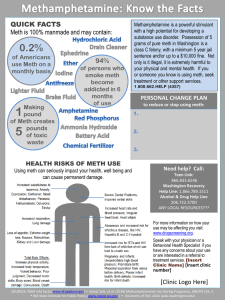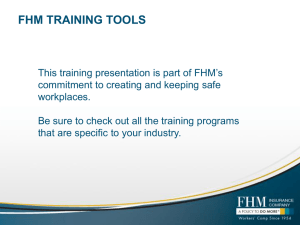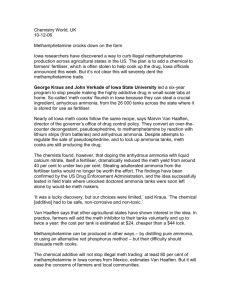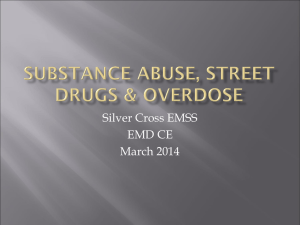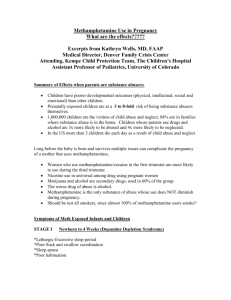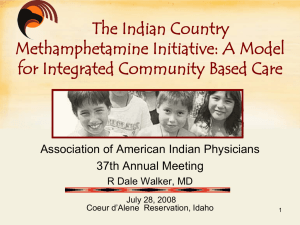Methamphetamine: Its Effects on You, the Environment, and Young
advertisement
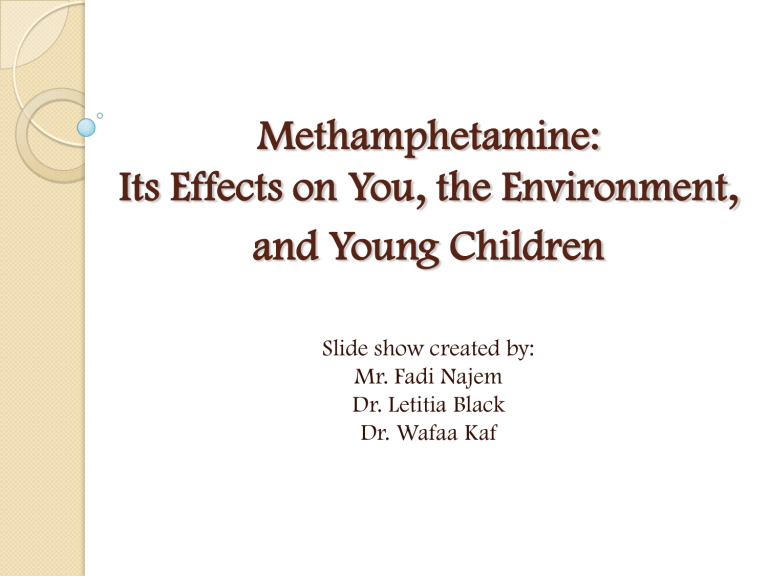
Methamphetamine: Its Effects on You, the Environment, and Young Children Slide show created by: Mr. Fadi Najem Dr. Letitia Black Dr. Wafaa Kaf Names of Methamphetamine Basic Facts About Meth It is a stimulant drug It is very addictive It is chemically related to amphetamines, but has more potent, longer lasting effects, that are more harmful to the central nervous system (CNS). Meth users feel a short yet intense "rush" when the drug is initially administered. Immediate effects include increased activity and decreased appetite. 2005 Nat’l Survey on Drug Use Estimated 10.4 million Americans aged 12 or older used methamphetamine at least once in their lifetimes for nonmedical reasons. This represents 4.3% of the U.S. population in that age group. Meth Abuse Treatment Admissions 1992 vs. 1996 (Red and blue areas = more admissions) http://www.methamphetamineaddiction.com/methamphetamine_hist.html Did you know that since 2000, there have been more than 15,000 children affected in meth labs and related incidents? www.thedenverchannel.com Meth is a Psychostimulant Pychostimulants temporarily increase alertness and wakefulness. Usually have increased side-effects with increased effectiveness. The more powerful variants are often prescription medicines or illegal drugs. Meth is Sympathomimetic Sympathomimetic drugs mimic the effects of the hormone Adrenaline and the hormone Noradrenaline. They all cause increased blood pressure. History of Meth 1893: First synthesized from ephedrine in Japan by chemist Nagayoshi Nagai. 1919: crystallized meth was synthesized by Akira Ogata via reduction of ephedrine using red phosphorus and iodine. http://en.wikipedia.org/wiki/Methamphetamine#World_War_II History One of the earliest uses of meth occurred during World War II when the German military dispensed it under the trade name Pervitin. http://en.wikipedia.org/wiki/Methamphetamine#World_War_II Adolf Hitler was given daily injections by his personal physician to treat depression and fatigue. It was speculated that Hitler had Parkinson's disease, but his symptoms may have been related to abuse of methamphetamines. http://en.wikipedia.org/wiki/Methamphetamine#World_War_II Post War Use 1950s: rise in the legal prescription of meth to the American public. 1960s: use illegally manufactured meth. The recreational use of methamphetamine peaked in the 1980s. http://en.wikipedia.org/wiki/Methamphetamine#World_War_II Legal Restriction in the U.S. 1983: laws were passed in the U.S. prohibiting possession of precursors and equipment for methamphetamine production. Since 1989, five federal laws and dozens of state laws have been imposed in an attempt to curb meth production. http://en.wikipedia.org/wiki/Methamphetamine#World_War_II Medical use of Meth Methamphetamine is used medically under the brand name “Desoxyn” for attention deficit hyperactivity disorder (ADHD), extreme obesity, and narcolepsy. Desoxyn is not generally prescribed for ADHD unless other stimulants or mixed amphetamines have failed. Tolerance Varies widely between individuals and even within one person. Highly dependent on dosage, duration of use and frequency of administration. Many cases of narcolepsy are treated with methamphetamine for years without escalating doses or any apparent loss of effect. Methamphetamine Effects Common Immediate Side Effects Euphoria Increased energy and attentiveness Diarrhea, nausea Excessive sweating Loss of appetite, insomnia, tremor, jawclenching (Bruxism) Agitation, compulsive fascination with repetitive tasks (Punding) Talkativeness, irritability, panic attacks Increased libido Dilated pupils Side Effects After Chronic Use Drug craving Weight loss Withdrawal-related Depression and Anhedonia Rapid tooth decay ("meth mouth") Amphetamine psychosis www.cityofwaynesboro.org www.tucsoncitizen.com Overdose Brain damage/ meningitis caused by lead poisoning (neurotoxicity) Paranoia, delusions, hallucinations, which may trigger a tension headache Overdose Formication (sensation of flesh crawling with bugs, with possible associated compulsive picking and infecting sores) Rhabdomyolysis (Muscle breakdown) which leads to Kidney failure Death from overdose is usually due to stroke, cardiac arrest or hyperthermia. Meth Mouth Abnormally quick loss of teeth. Probable causes - xerostomia (dry mouth), poor oral hygiene, frequent consumption of high calorie, carbonated beverages, tooth grinding/clenching. Risky Behavior STDs - Disregard for the potential dangers of unprotected sex or other reckless sexual behavior may contribute to the spread of sexually transmitted diseases. Increased need and urgency for sex, the ability to have sex for extended periods of time, and an inability to ejaculate or reach orgasm or physical release. Addiction on Methamphetamine Methamphetamine-induced hyperstimulation of pleasure pathways leads to anhedonia, (feeling pleasure). Former users note that they feel stupid or dull when they quit using. Ingredients of Meth Battery Acid Cold Medicine Drain Cleaner Acetone Rock salt Lye Antifreeze Kitty Litter Lithium batteries Toluene What Are Some Physical Signs That Someone Is Using Meth? No sleep for 2-3 days Dramatic weight loss Paranoia Aggressive behavior Extreme energy Grinding teeth Obsessive picking of the face or body Hallucinations, (auditory or visual) Euphoria Intake - Smoking Meth Fumes are vaporized rather than burned and inhaled, as with tobacco. Glass pipes or aluminum foil heated by a flame are used. Also known as "chasing the white dragon" or more commonly called "Clucking". Intake - Injection Injection is a popular method, also known as slamming. Users often have skin rashes ("speed bumps") and infections at the site of injection. Injecting is very risky! The hydrochloride salt of meth is soluble in water, so injection users can use any dose from 125 mg to over a gram with a small needle. This dosage range may be fatal to nonaddicts. Sharing needles without sterilization procedures can spread blood-borne diseases such as HIV or hepatitis. Another way of Ingesting Meth Crush the crystals up and insufflate them. This bypasses first pass metabolism and goes straight into the bloodstream. Legality: Australia: Strictly used. Canada: Meth is not approved for medical use in Canada. Hong Kong: It can only be used legally by health professionals and for university research purposes. The Netherlands: Meth is not approved for medical use. New Zealand: Doctors can prescribe it for an appropriate indication, but case-by-case approval by the director-general of public health is mandatory. United States: Methamphetamine is classified as a Schedule II which means: ◦ (A) There is a high potential for abuse. ◦ (B) There is a currently accepted medical use in treatment in the United States or a currently accepted medical use with severe restrictions. ◦ (C) Abuse may lead to severe psychological or physical dependence. http://www.dea.gov/pubs/abuse/1-csa.htm#Schedule II More Information About Meth http://www.usdoj.gov/dea/p ubs/pressrel/methfact03.html http://www.montanameth.org /index.php See forum handouts Quiz – Test your knowledge! 1. Methamphetamine is able to act in the brain because it has a structure similar to which brain chemical? ◦ ◦ ◦ ◦ a. Endorphin b. Amygdala c. Chocolate d. Dopamine d. Dopamine, sometimes called the pleasure chemical, has a shape and chemical structure that is similar to Methamphetamine. This is part of why Methamphetamine is able to cause its many effects in the brain. 2. Which of the following are effects of Methamphetamine? ◦ ◦ ◦ ◦ a. Increased heart rate b. Difficulty sleeping c. Aggressiveness d. All of the above d. Methamphetamine can also cause certain types of hallucinations, loss of appetite and even strokes. 3. True or False: ◦ Methamphetamine can cause long term damage to neurons that contain the neurotransmitter dopamine. True. Researchers have found that even years after Methamphetamine users have stopped using the drug, their dopamine neurons are still damaged. "It all started out with that first hit. Just something to take the pain away. I was only on Meth for 6 months, but those were the worst months of my life. I lost my virginity and I tried suicide several times." Anonymous female (age 21)
